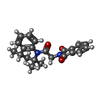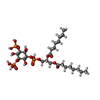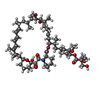+Search query
-Structure paper
| Title | Structural mechanism of allosteric activation of TRPML1 by PI(3,5)P and rapamycin. |
|---|---|
| Journal, issue, pages | Proc Natl Acad Sci U S A, Vol. 119, Issue 7, Year 2022 |
| Publish date | Feb 15, 2022 |
 Authors Authors | Ninghai Gan / Yan Han / Weizhong Zeng / Yan Wang / Jing Xue / Youxing Jiang /  |
| PubMed Abstract | Transient receptor potential mucolipin 1 (TRPML1) is a Ca-permeable, nonselective cation channel ubiquitously expressed in the endolysosomes of mammalian cells and its loss-of-function mutations are ...Transient receptor potential mucolipin 1 (TRPML1) is a Ca-permeable, nonselective cation channel ubiquitously expressed in the endolysosomes of mammalian cells and its loss-of-function mutations are the direct cause of type IV mucolipidosis (MLIV), an autosomal recessive lysosomal storage disease. TRPML1 is a ligand-gated channel that can be activated by phosphatidylinositol 3,5-bisphosphate [PI(3,5)P] as well as some synthetic small-molecule agonists. Recently, rapamycin has also been shown to directly bind and activate TRPML1. Interestingly, both PI(3,5)P and rapamycin have low efficacy in channel activation individually but together they work cooperatively and activate the channel with high potency. To reveal the structural basis underlying the synergistic activation of TRPML1 by PI(3,5)P and rapamycin, we determined the high-resolution cryoelectron microscopy (cryo-EM) structures of the mouse TRPML1 channel in various states, including apo closed, PI(3,5)P-bound closed, and PI(3,5)P/temsirolimus (a rapamycin analog)-bound open states. These structures, combined with electrophysiology, elucidate the molecular details of ligand binding and provide structural insight into how the TRPML1 channel integrates two distantly bound ligand stimuli and facilitates channel opening. |
 External links External links |  Proc Natl Acad Sci U S A / Proc Natl Acad Sci U S A /  PubMed:35131932 / PubMed:35131932 /  PubMed Central PubMed Central |
| Methods | EM (single particle) |
| Resolution | 2.11 - 2.598 Å |
| Structure data | EMDB-25377, PDB-7sq6: EMDB-25378, PDB-7sq7: EMDB-25379, PDB-7sq8: EMDB-25380, PDB-7sq9: |
| Chemicals |  ChemComp-AQV:  ChemComp-NA:  ChemComp-HOH:  ChemComp-EUJ:  ChemComp-A4I: |
| Source |
|
 Keywords Keywords | MEMBRANE PROTEIN / ion channel |
 Movie
Movie Controller
Controller Structure viewers
Structure viewers About Yorodumi Papers
About Yorodumi Papers












